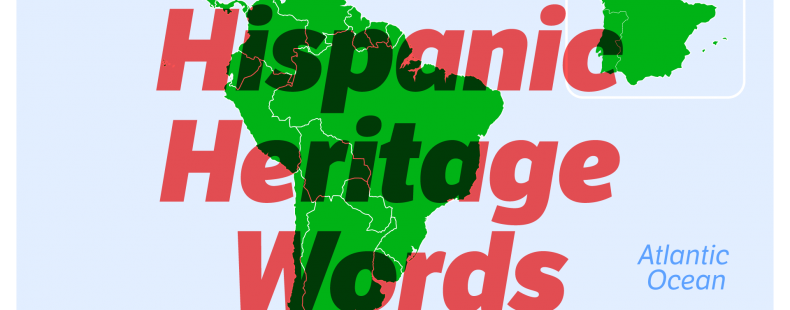The contributions of Latino Americans and the influence of Hispanic American culture extends far beyond the history and borders of the US. Fittingly, the celebration and exploration of these heritages and histories must extend beyond Hispanic Heritage Month.
In this article, we’ll focus on eight key terms crucial to understanding and exploring both the richness and joys of these cultures and identities as well as the struggles and discrimination Hispanic and Latino people have faced and continue to face—and overcome.
While this article can’t possibly cover the entirety of the experiences of Latinos and Hispanic people in the US, it encompasses many of the key events that contributed to the formation of a pan-ethnic identity.
Content warning: This article includes some detailed content on anti-Latino violence and slurs.
✏️ A note about Hispanic, Latino, Latinx, and Latine
The word Hispanic carries with it the specification of a person’s language, referring to people from or with a heritage rooted in Spanish-speaking Latin American countries or Spain. Latino is used as an identifier among people from or with a heritage rooted in Latin America, irrespective of language and inclusive of countries where Spanish is not the most widely spoken language, such as Brazil and Haiti. Of course, for many people, both terms apply. Latinx and Latine are both gender-neutral versions of Latino and Latina. However, not everyone with this heritage uses these terms, with many continuing to use Latino as a gender-neutral default. In this article, we’ll use different terms in different contexts.
Read more about the difference between Hispanic and Latino and the distinction between Latinx and Latine.
Diversity
A word commonly used in the context of Latino experiences is Latinidad, which roughly means “Latino-ness.” Terms like this can reflect how much Latino people—almost 20% of the US population—have in common. But this demographic is not a monolith. In particular, some criticize Latinidad for generalizing and missing nuances of identity, such as variations in language, race, and culture. This is why the term diversity is so important to keep in mind when discussing the variety of Latino experiences.
For instance, while Spain had an indelible impact on the Americas, not all Latinx people are of Spanish descent. Moreover, some people object to the terms Hispanic and Latino (and the alternative terms derived from it) due to their Eurocentric roots, which can have the effect of erasing the African, Indigenous, and other non-European heritages and histories of many people in these communities.
Many iconic aspects of Hispanic and Latinx culture have African and Indigenous roots, including those related to symbols (the eagle and snake on Mexico’s flag), arts and sports (ñandutí, ulama), music (cumbia, reggaeton), and food (mofongo, tamales, tortillas).
Recognizing these identities as part of Latinx heritage ensures that we acknowledge the histories and cultures that predate and endured colonization.
Learn more about the history of Caribbean and Latin American music and dance.
Colonization
The origin of Latino identity is inseparable from one of the most formative and destructive points in the history of the Western Hemisphere: the Spanish invasion of the Americas.
On August 13, 1521, Spanish conquistadors overtook the city of Tenochtitlán, the capital ruled by the Mexica [ meh-shee-cah ] people in what is now commonly known as the Aztec Empire. The introduction of foreign disease and Spanish alliances with other Indigenous Peoples were critical factors in the conquest.
Indigenous lands in the Americas became a destination for colonization and subjugation by the Spanish and other Europeans, who referred to these lands as “the New World.” In the 500 years since, whole cultures, ways of life, and repositories of knowledge have been lost. Conversely, new blends of languages and cultures took root.
Colonization is the act of a foreign entity establishing control over a region and, typically, the people already inhabiting that region. Spain’s enforcement of its Sistema de Castas (Caste System) throughout its colonization is often cited as the root of the establishment of white supremacy in Latin America. This particular system placed European-born Spaniards (peninsulares) at the top of the order, followed by Latin American-born Spaniards (criollos), and then variations of mixed ancestry between white Europeans, Native peoples, and enslaved African peoples in descending order. Enslaved Africans were considered the bottom caste.
In addition to it being a foundation of racist violence and discrimination, this system is often thought to have created a legacy of internalized racism that values white identity as superior and perpetuates anti-Blackness. A related concept is that of mestizaje, which grew out of early 20th-century nationalistic propaganda in Mexico. Mestizaje has been criticized as a mythologizing of blended Indigenous and Spanish ancestry that frames European identity as aspirational and romanticizes Indigeneity as a past identity, often to be viewed as inferior. Critics of this centralizing of Spanish and Indigenous ancestry note that it can exclude and erase Black history and ancestry as well as the identity and contributions of others, such as those with a heritage also rooted in Asia and the Middle East.
These systems of oppression contributed to Spain and Portugal’s dominance over Latin America for nearly 300 years until the early 1800s.
Revolution
From 1808–1833, numerous Latin and South American peoples across multiple territories fought for political independence in various and interrelated conflicts now referred to as the Spanish American Wars of Independence. These revolutions began as localized civil wars that later spread and expanded as secessionist conflicts in pursuit of general independence from Spain. Relatedly, Brazil achieved independence from Portugal during the same period.
The newly independent nations in Latin America created new national boundaries based on the former Spanish colonial provinces, eventually becoming the independent countries of contemporary Latin America. While slavery was not abolished until later, the newly formed states took official actions to abandon the Spanish-derived caste system, the Inquisition, and noble titles.
Even though Spanish was a shared language during the period of Spain’s rule, it was still not a dominant language across all Latin American countries. Many Indigenous languages were still in common use—a reality that changed in the next century.
Learn about the history and meaning of Indigenous Peoples’ Day.
Imperialism
Imperialism is the pursuit and maintaining of political and economic dominance over one region by another. Through multiple wars over nearly 25 years, most of Latin America (with exceptions such as Cuba and Puerto Rico) broke free of Spanish imperialism. However, imperialism in the region was not limited to Spain.
In 1821, Mexico officially gained its independence from Spain, and its territories included what are now several US states (including Texas, New Mexico, Arizona, Utah, and California). In the US, westward expansion increased following the Louisiana Purchase. Such expansion was perceived as a divine right, branded as Manifest Destiny.
Mexico, in part as a way to displace Comanche peoples living there, initially welcomed US immigrants into its territory of Texas. But, with assistance from the US, Texas broke away from Mexico, forming its own republic. The ensuing US-Mexico War (1846–1848) resulted in heavy casualties and a massive loss of territory for Mexico, yielding much of what would become the southwestern US.
Many of the Mexicans who were inhabitants of the newly acquired US land remained there. But as more Americans moved westward, especially during the California Gold Rush, efforts to actively displace and marginalize Mexican Americans increased.
The US continued to expand, including in the Caribbean. Through the Spanish-American War (1898), the US acquired Puerto Rico from Spain, which also ceded the Philippines and Guam. Despite Cuban rebels’ role in defeating Spanish forces, Cubans were not included in the discussions or signing of the resulting Treaty of Paris, and tensions between the US and Cuba continued into the 20th century.
Puerto Ricans were recognized as US citizens in 1917. However, because Puerto Rico is classified as an unincorporated territory, Puerto Ricans do not have a voting representative in Congress and do not have the ability to vote in presidential elections. Many Puerto Ricans view this as disenfranchisement and among the main motivations for the pursuit of statehood for Puerto Rico.
Civil Rights
Despite the adoption of major amendments in the US in the 1800s relating to civil rights, People of Color (including of Black, Indigenous, Latino, and Asian Americans) continued to be targeted by government-sanctioned segregation and violence.
Many Latinos, specifically Mexican Americans, were often the target of lynchings. Notably in the 1910s, Mexican immigrants and Mexican American citizens were specifically targeted in Texas by the state agency known as the Texas Rangers. In addition to many acts of violence, the Rangers raided and destroyed the printing presses of the newspaper El Progreso, whose editor, Jovita Idar, had published criticism of their practices.
A well-known instance of violence specifically targeting Latinos occurred in and around Los Angeles during the event known as the Zoot Suit Riots, from June 3–8, 1943. Ongoing clashes between Mexican American youths and white servicemen stationed in Southern California escalated when mobs of service members, off-duty police officers, and others targeted Mexican American men and others with beatings in the streets. The event is named for the zoot suit, a baggy suit that was an iconic part of fashionable youth culture at the time, especially among Black and Mexican American men.
Among service members, zoot suits were sometimes viewed as unpatriotic due to requiring an excessive amount of fabric during wartime rations. Still, such motivations were used by many simply as a pretense for racist mob violence. Due to its association with People of Color, the zoot suit became an easily identifiable target. As in the case of many other instances of events later popularly referred to as riots, the mob violence was largely ignored or even assisted by members of the police, and the victims were the ones who were arrested.
The prominence of the event during the midst of World War II often obscures the significant numbers of Mexican Americans and other Latinos who served in the military during the time.
Around the same time, many Latinos participated in the Bracero Program (1942–1947), which contracted Mexican farmworkers in exchange for employment and shelter to compensate for the drop in US-based farm laborers during the war. But then, in 1954, the US government carried out Operation Wetback (using the slur that derogatorily refers to Mexican laborers), a mass deportation of both Mexican immigrants and Mexican American citizens. The event spurred many Latinos to pursue the legal right to equal treatment.
That same year, a unanimous ruling in Hernandez v. Texas held that Mexican Americans and all other nationality groups in the United States have equal protection under the 14th Amendment of the Constitution. Earlier, in 1947, the ruling in the landmark case Mendez v. Westminster held that the forced segregation of Mexican American students into separate “Mexican schools” was unconstitutional. A precursor for future civil rights gains, it set a precedent for the 1955 ruling in Brown vs. Board of Education, which outlawed segregation in public schools.
Both of these cases were significant in the early Chicano Movement. Against the backdrop of the national Civil Rights Movement and the antiwar movement in response to the US involvement in Vietnam, the Chicano Movement (also known as El Movimiento) was influenced by and entwined with the Black Power movement. Both strove for community empowerment and liberation while also calling for Black-Brown unity. Protests for better quality education, led by Chicano organizations like the Brown Berets and Mexican American Youth Organization (MAYO), were influenced by Black activist organizations such as the Black Panthers. Chicano political demonstrations, such as the East LA Walkouts (1968) and the Chicano Moratorium (1969–1971), occurred in collaboration with Black students and activists.
Such collaboration was crucial to political gains across different sectors, including the United Farmworkers Movement. Leaders such as César Chávez and Dolores Huerta worked closely with Filipino community leaders, such as Modesto “Larry” Dulay Itliong. Among their most successful protests was the Delano grape strike of 1965–1970, which led to increased wages and improved working conditions, including unemployment insurance, paid vacation days, and the creation of a special benefits fund.
Within the Chicano Movement, Chicana women who were often marginalized criticized the movement’s culture of machismo (referring to a strong or exaggerated sense of manliness and an entitlement to dominate). In particular, Chicana feminists worked to bring awareness and action to issues including the forced sterilization of Latina women and violence against women of color and members of the LGBTQ+ community.
While the Chicano Movement was predominantly led by Mexican American activists, it encompassed many other Latino identities. The legacy of the Chicano Movement includes positive advancements in labor rights, education, and politics, as well as a new profusion of mural art and craft styles, such as rasquache.
Immigration
In the US, Latinos are often viewed as the face of immigration. This has positive aspects, including the pride that many Latinos take in being part of the fabric of American culture. But the association also results in racist and xenophobic attacks, discrimination, stereotypes, and the “othering” of Latinos as “perpetual foreigners.” This perception disregards the fact that many individuals are naturalized or native-born citizens or that their families have been living in the US for multiple generations. According to 2021 data, four out of five Latinos living in the US are citizens and more than two-thirds are US-born.
Undocumented immigrants from Mexico and Central America are especially targeted with violence as well as policies that limit their access to basic resources. The separation of families and children at the US-Mexico border has resulted in more than 120,000 migrant children being taken into US custody and held in barred cells without their parents.
All Latinos are more likely to be racially profiled on the pretext of checking immigration status, leaving them increasingly vulnerable to traffic stops and unwarranted searches.
Advocates note that such violence and discrimination is often provoked by increasingly inflammatory rhetoric around immigration, including hate speech meant to incite violence against Latino communities.
Despite such ongoing oppression, Latinos and Latino immigrants continue to play a significant role in shaping and influencing culture in the US and beyond.
Cultura
With interlocking histories, various Latino cultures are inseparable from US culture and so many of its aspects, including language, commerce, arts, and everyday life.
A countless number of English words are derived from Spanish. Today, Spanish is spoken in 41 million US homes, and it’s the second most studied language in educational institutions. Latino surnames like Garcia, Rodriguez, and Martinez are some of the most common in the US. Latinos account for one out of every five US college students. The purchasing power of Latinos in the US is expected to climb to $2.6 trillion by 2024.
Achievements and contributions by Latinos span across all facets of society, from pop culture to science and medicine.
Mexican and Latin American cuisine have become staples of what Americans eat and cook.
Latino contributions to music abound and span multiple genres, with stars including Ritchie Valens, Celia Cruz, Tito Puente, Carlos Santana, Selena Quintanilla, Jennifer Lopez, Shakira, and Lin-Manuel Miranda. In 2020, Puerto Rico’s Bad Bunny became the first Latino to be the most-streamed artist of the year on Spotify (a feat he repeated in 2021 and 2022).
Read 10 insightful quotes from Hispanic authors.
Latino luminaries in science include Nobel Prize-winning biochemist César Milstein, whose work developed new treatments for autoimmune diseases, and neuroscientist Alfredo Quiñones-Hinojosa, who developed minimally invasive techniques in neurosurgery with the use of nanotechnology. Ellen Ochoa was the first Latina astronaut to go into space and holds three patents related to optical systems that she invented for aerospace missions.
In 2021, Charise Castro Smith became the first Latina director in the history of Walt Disney Studios with the release of its 60th animated feature film, Encanto. Such milestones are examples of how Latinos are pursuing better representation in media and beyond. A 2021 report from USC Annenberg found that Latinos held only 5% of all speaking roles in the 1,300 top-grossing films from 2007-2019. Additionally, Latino characters still often portray stereotypes, perpetuating them in public perception. Proper representation is key in helping more people understand the experiences and perspectives of Latinos as well as ensuring that Latinos are in positions to tell their stories authentically.
Even more crucially, Latinos are continuing to pursue political representation. Despite the fact that Latinos account for 18% of the US population (based on census data from 2020), fewer than 10% of members of Congress are Latino. At the same time, several Latinx figures have become visible on the national stage, perhaps most prominently Puerto Rican American Supreme Court Justice Sonia Sotomayor.
Heritage
Observances like Hispanic Heritage Month are a crucial way to recognize these contributions, which often go unacknowledged.
U.S. Rep. Esteban Torres of California, who worked to promote and develop Hispanic Heritage Month, said this about why it matters:
“[We] want the American people to learn of our heritage. We want the public to know that we share a legacy with the rest of the country, a legacy that includes artists, writers, Olympic champions, and leaders in business, government, cinema, and science.”
In December 2020, the Smithsonian established the National Museum of the American Latino. Gradually, more Latino stories are being told. Learning and recognizing the diverse cultures, lived experiences, and narratives among Latinos is key to not only understanding the collective history of the US but also our shared future.














